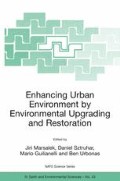7. Summary and conclusions
About 3,500 million EUR have to be invested for the development, upgrading, reconstruction and rehabilitation of the urban water infrastructure in Bulgaria, including 2,200 million EUR for the sewer networks and WWTPs. Support from the international financial institutions and participation of the private sector are considered to be crucial importance for the implementation of relevant projects. Currently 41 municipal wastewater treatment plants (out of 61 plants in operation in the country) use conventional secondary treatment technologies and serve 67 population centres with about 40% of the country population. In the Implementation Programme for WWTPs, 430 municipal WWTPs are scheduled for implementation by 2015, among which 61 are already in operation, 12 are to be completed in the near future and for 19 plants the design documentation is available. In Stage I of the National Programme for WWTPs (covering the period up to 2007) 36 municipal WWTPs are included in the first priority group for construction, completion, reconstruction or upgrading at a cost of 325.5 million EUR. Technological flowcharts of almost all the existing WWTPs, most of which are expected to require reconstruction and upgrading, do not comply with the requirements of the newly established Sensitive Zones Ordinance or meet them only partially. Furthermore, almost all of the WWTPs technological flowcharts include chlorination for disinfection, which is forbidden in the EU. In this respect disinfection with ultra-violet irradiation is recommended, which was originally planned only at one WWTP. Significant infiltration is observed in almost all of the sewer networks currently in operation, which changes drastically the wastewater quality parameters and creates serious problems for implementing advanced wastewater treatment technologies, and biological nutrient removal, in particular. Nevertheless most of the WWTPs design projects do not consider the fact of wastewater dilution and assume normal wastewater quality, which makes them inadequate. The general conclusion is that the flowcharts of the WWTPs under consideration need to be modified and additional funding be secured for their implementation in very near future. In this respect the implementation of several advanced wastewater treatment technologies is suggested, including those which are suitable for highly diluted wastewater.
Access this chapter
Tax calculation will be finalised at checkout
Purchases are for personal use only
Preview
Unable to display preview. Download preview PDF.
8. References
Directive 91/271/EEC Concerning Urban Wastewater Treatment (1991). EU Commission, Brussels.
Implementation Program for Directive 91/271/EC Concerning Urban Wastewater Treatment (2003), MEW, Sofia.
National Program for Construction of Sewer Networks and Main Trunks to the WWTPs for Settlements with Over 10 000 PE (2001), MRDPW, Sofia.
National Program for Priority Construction of Urban Waste Water Treatment Plants for Settlements with Over 10 000 PE (1999), MEW, Sofia.
Ordinance for Establishing Sensitive Zones (2003), MEW, Sofia.
Regulation 6 on the Wastewater Emission Standards for Admissible Contents of Harmful and Dangerous Substances Discharged in Water Bodies (2000), State Gazette, No. 97, Sofia.
Schmidt, I., O. Sliekers, M. Schmid, E. Bock, J. Fuerst, J. G. Kuenen, M. Jetten and M. Strous. (2003), New Concepts of Microbial Treatment Processes for the Nitrogen Removal in Wastewater. FEMS Microbiology Reviews 777, p. 1–12, Elsevier Sciences B.V.
Van Dongen, L.G.J.M., M.S.M. Jetten and M.C.M. van Loosdrecht. (2001). The Combined Sharon/Anammox Process, IWA Publishing, London.
Water Framework Directive 2000/60/EEC (2000), EU Commission, Luxembourg.
Water Act (1999), State Gazette, No 67/1999, Sofia.
Author information
Authors and Affiliations
Editor information
Editors and Affiliations
Rights and permissions
Copyright information
© 2004 Kluwer Academic Publishers
About this paper
Cite this paper
Arsov, R.V., Teneva, N. (2004). Bulgarian Policy and Actions for Municipal WWTPs Construction and Upgrading. In: Marsalek, J., Sztruhar, D., Giulianelli, M., Urbonas, B. (eds) Enhancing Urban Environment by Environmental Upgrading and Restoration. Nato Science Series: IV: Earth and Environmental Sciences, vol 43. Springer, Dordrecht. https://doi.org/10.1007/1-4020-2694-3_18
Download citation
DOI: https://doi.org/10.1007/1-4020-2694-3_18
Publisher Name: Springer, Dordrecht
Print ISBN: 978-1-4020-2692-8
Online ISBN: 978-1-4020-2694-2
eBook Packages: Earth and Environmental ScienceEarth and Environmental Science (R0)

